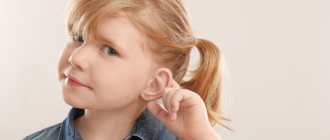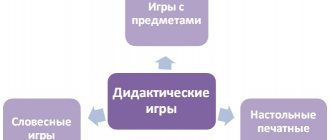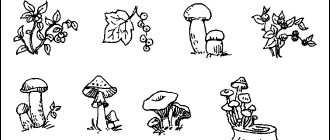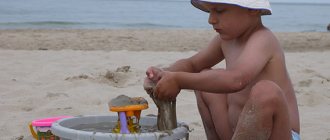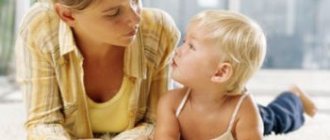Are you worried that your child won’t speak? Want to study at home, but don't know where to start? Are you planning to see a speech therapist? When a child aged 2.5 - 3 years has not begun to speak, you cannot do without the help of a speech therapist, but there is something you can do on your own. One of the main conditions for speech development is continuity, so it is important not only to study regularly with a specialist, but also to find time at home every day to do tasks to start speech. From this article you will learn about the most interesting and effective exercises that both adults and children will enjoy.
How do children develop the need to speak?
Speech therapists often advise parents to talk to their children more often, but not all mothers and fathers do everything right. Any language is a sign system, and a word, in fact, replaces a specific object, that is, it has a certain meaning. If communication between a child under the age of 1.5 years and his parents comes down to only manifestations of care and love, or the child prefers to play alone, then speech will not appear soon, even if quite a lot of words have been accumulated in the dictionary. For speech to appear, it is necessary that:
- the child needed to communicate with an adult: name an object, express feelings, ask for something;
- communication was meaningful: about toys, actions, impressions;
- adults talked to the baby for a reason, namely about joint actions, play;
- the child needed an object that had to be named in order to receive it.
When a baby finds himself in a situation of objective cooperation, he is faced with a speech task, and in order to solve it, he has to change his entire behavior.
The only way to get the desired item is only a verbal request, naming the item with a certain word. The only assistant here is an adult.
Speech therapists distinguish three stages in the acquisition of words by non-speaking children.
The emergence of a need for an item
These could be pictures, toys, cubes, books, clothes, treats, etc. The child wants to receive it, pulls his arms, tries to attract the mother’s attention with facial expressions and gestures. Sometimes unsuccessful attempts lead to crying and anger, but gradually the child understands that he can ask an adult for help.
Make sure your child is healthy
Long-term absence of speech can be associated with the consequences of severe infections suffered in early childhood, difficult pregnancy and childbirth, impaired hearing function, damage to the central nervous system, as well as stress. This is why it is so important to first make sure that the child does not have any health problems. Be sure to visit a pediatrician, otolaryngologist, neurologist, speech therapist and undergo the necessary research. Early diagnosis and correction of disorders is half the success of developmental activities. Create a welcoming, calm atmosphere at home. Children are sensitive to changes in the emotional climate in the family. If mom and dad often quarrel, children instinctively try to attract as little attention to themselves as possible.
We start talking while playing
Play is the leading activity for children; speech development is possible only through joint games and activities with an adult. Start with the simplest exercises so that the child can easily master them and constantly be in a situation of success.
Sounds and hands
Move your arms and legs and make a specific sound for each gesture. For example, we spread our arms to the sides and sing: “Ahhh”, put our palms to the corners of our mouth for “Uuuu”, put our feet shoulder-width apart for “Iiiiiii”, interlock our fingers and raise our hands above our heads for “Ooooh”, etc. .
Let's play ball
Sit on the floor with your child, spread your legs wide, throw the ball to the baby and say, “Let's play! Catch the ball, catch it,” emphasizing the verb “catch” with intonation. This way, you will encourage your child to say the word when he throws the ball back to you. Do the same when you roll the ball: “Roll the ball, roll!” The game should be emotional, so don't skimp on encouragement and praise.
"Alarm"
Children usually enjoy this exercise. Before performing it, it is advisable to make sure that the child has a rough idea of what a clock is. Say that now you will turn the baby into an alarm clock, and “wind up” him: make several circular movements with your finger on the child’s palm, stomach, head or back, saying: “tick-tock”, “tick-tock”. Now it should ring: shake your palm rhythmically, accompanying the movements with the sound “zzzzz”. Then suggest to your baby that you should be the alarm clock, and he should set you off. At first, help your child pronounce the necessary words and sounds; the more often you repeat the game, the faster he will remember these onomatopoeias.
"Train"
Stand with your child one behind the other, explain to your child that now you are train cars and will make many interesting journeys. Each family member can become a carriage in your train. As you move, make sounds like “tu-tuu-tu, chuh-chuh-chuh, tuuuu!”, encouraging your child to say them with you. While traveling around the apartment, comment on everything you see: “here is the washing machine, and here is the kitchen, now we’ll go to the nursery to get toys,” etc.
"Drip-drip-drip"
For this activity you will need a set of small colored dish sponges. Place two bowls on the table: one empty and the other with water, place sponges nearby so that the child can choose any one. Take one, wet it and squeeze it into an empty bowl, saying “drip-drip-drip.” Invite your child to do the same with other sponges.
"Bubbles"
This game helps the child learn to control his speech organs. You blow soap bubbles, and the child must pop them, simultaneously pronouncing paired sounds: “b” - “p”, “v” - “f”, “t” - “d” and others. Help your child by saying sounds with him.
"Talking Ball"
Take a small ball that fits in your palm, you can crochet it and fill it with rice or cereal, then it will gently massage children's hands. Transfer the ball from hand to hand and pronounce the sounds first (it is better to start with vowels and voiced consonants), and then, as the child masters the exercise, the syllables: KI-SA, MA-MA, BA-BA, DE-DA, etc. d.
A set of activities for non-speaking children aged 3-7 years
The set of classes “System of working with non-speaking children with delays and deviations in the development of preschool age” is addressed to children aged 3 to 7 years.
Provides:
- Development of active speech to the level of onomatopoeia, babbling and simple common words: names of family members, parts of the body and face, the use of onomatopoeia related to domestic and wild animals, to vehicles;
- Distinguishing paired pictures that differ in external characteristics
- Distinguishing pictures of animals, birds and their young, Understanding the actions and characteristics of objects;
- Distinguishing the color, shape and size of objects;
- Selecting one toy from several;
- Development of constructive praxis;
- Consolidation of previously learned articulatory movements;
- Drawing simple geometric shapes, painting them, shading, tracing stencil shapes.
Lesson No. 1. Lexical topic “Family”.
- DEVELOPMENT OF FINE MOTOR SKILLS:
This finger is grandpa
This finger is grandma
This finger is daddy
This finger is mommy
This finger is me
That's my whole family. (stroke your fingers alternately from base to tip, starting with the thumb on both hands in turn).
2. EXERCISE TO DEVELOP BREATHING: “Play ball with the boy” (blow on a paper ball).
3. DEVELOPMENT OF ARTICULATIVE MOTOR SKILLS: “Family” Dad, mommy and I are a friendly family together. Dad smiles, mom smiles, I smile (smile widely, showing my teeth). Dad is surprised, mom is surprised, I’m surprised. (raise your eyebrows, purse your lips as if pronouncing a sound (o). Daddy swears, mommy swears (shake your index finger, frown your eyebrows, purse your lips). I apologize (make a guilty face, bite your lower lip).
4. DEVELOPMENT OF SPEECH UNDERSTANDING: Examination of the plot picture “Family”. - Show your mom, dad, grandpa, grandma, boy, girl.
5. DEVELOPMENT OF SPEECH IMITATION: The child names family members (mom, dad, woman, grandfather, son, daughter.) Then the speech therapist asks questions: Who is little? (son daughter). Who is big? (mother, father, woman, grandfather). What mom? Etc. Who is standing? Who's sitting? Who's playing? Who is drawing? Who's cooking? (child's answers).
6. DEVELOPMENT OF NON-SPEECH MENTAL PROCESSES (VISUAL ATTENTION, MEMORY, THINKING): Game “Who ran away?” (based on pictures of family members).
7. DEVELOPMENT OF AUDITORY ATTENTION: “Guess who’s talking?” (computer program “Learning to speak correctly”)
8. SENSORY DEVELOPMENT: Speech therapist: Who has a red jacket, a green dress?
9. DEVELOPMENT OF GRAPHOMOTOR SKILLS: let's draw mom.
Lesson No. 2. Lexical topic: “Pets.”
- DEVELOPMENT OF FINE MOTOR SKILLS: All fingers “jump” across the table: Along a white, smooth road
Fingers gallop like horses:
Clack-clack-clack, clink-clack-clack,
A frisky herd gallops.
2. EXERCISE TO DEVELOP BREATHING: “Play with the kitten” (blow off a paper bow).
3. DEVELOPMENT OF ARTICULATIVE MOTOR SKILLS: “Cat” The cat loves milk very much, she laps it from the saucer like this: stick out her wide tongue from her mouth and make lapping movements with it. The cat lapped the milk and then licked its mouth (lick the lips with a circular motion of the tongue). The cat washed itself and went hunting. He lies near the hole, guarding the mouse in the hole. A mouse will crawl out of its hole, and the cat will grab it and catch it. Like this... (lips in a smile, slowly stick the pointed tip of the tongue out of the mouth, then bite the tongue with your teeth). We will praise the cat Murka and give him a pink bow. Like this... (open your mouth, rest the wide tip of your tongue on your lower teeth, and bend the middle part of your tongue in the form of a slide and roll it out of your mouth, then bite your tongue).
4. DEVELOPMENT OF SPEECH UNDERSTANDING: Game “Find a Pair” (2 different toys each of a cow, a cat, a dog, a horse, a pig).
5. DEVELOPMENT OF SPEECH IMITATION: Name domestic animals - kitty, awka (dog), horse. Game "Help the baby find its mother." Speech therapist: Baby pets were walking on the lawn and got lost. How will a kitten call its mother? (if the child finds it difficult, then give an example of onomatopoeia).
6. DEVELOPMENT OF NON-SPEECH MENTAL PROCESSES (visual attention, memory, thinking): put together a cut-out picture of a pet.
7. DEVELOPMENT OF AUDITORY ATTENTION: “Who gives what voice?” There are different pets living in the village: a horse, a dog, a cow, etc. They all sing their favorite songs. Guess who's singing? (Moo, i-go-go, be, oink-oink), etc. (with toys) or the computer game “Learning to speak correctly. Barnyard".
8. SENSORY DEVELOPMENT: based on pictures of animals and their babies. Speech therapist: show who is big and who is small.
9. DEVELOPMENT OF GRAPHOMOTOR SKILLS: coloring the “kitten” picture.
Lesson No. 3. Lexical topic: “Wild animals.”
1. DEVELOPMENT OF FINE MOTOR SKILLS: “A squirrel is sitting on a cart” A squirrel is sitting on a cart, selling its nuts. (with your right hand, bend the fingers on your left one in turn, and then vice versa) To the little sister fox, sparrow, titmouse, clubfooted bear and mustachioed bunny.
2. EXERCISE TO DEVELOP BREATHING: “The animals went for a walk” (blow on the paper animals).
3. DEVELOPMENT OF ARTICULATIVE MOTOR SKILLS: “In the forest” We visited the forest and met a fox there. The fox has a sharp long muzzle, like this... (stretch out your lips with a tube and hold them in this position for several seconds). A bear was dozing under a pine tree. When he woke up, he began to roar (pronounce the sound (e) for a long time, while opening his mouth and moving his lips slightly forward). The little bunny heard him and began to gnaw the root - the stalk (raise his upper lip, click his teeth). And along the branches, hopping and hopping, the squirrel is a red-haired animal. Let's treat her to a nut. Look, the squirrel puts a nut on its cheek, and then on the other. Like this... (the tip of the tongue rests either on the right or on the left cheek, protruding it from the inside).
4. DEVELOPMENT OF SPEECH UNDERSTANDING: Game “Where is the bear?” etc. (child shows a toy).
5. DEVELOPMENT OF SPEECH IMITATION: (Bear, wolf, fox).
6. DEVELOPMENT OF NON-SPEECH MENTAL PROCESSES (visual attention, memory, thinking): “The fourth odd one” (based on pictures or toys of wild animals + a toy that is not related to wild animals).
7. DEVELOPMENT OF AUDITORY ATTENTION: “Who plays how?” The bear plays the drum “bom-bom”, the bunny plays the pipe “doo-doo!”, the fox plays the piano “la-la”. Guess who's playing: doo-doo, la-la, bom-bom? (both sounds and movements should be shown).
8. SENSORY DEVELOPMENT: The game “Hide the toy in your palms” to form ideas about size. (big and small squirrel).
9. DEVELOPMENT OF GRAPHOMOTOR SKILLS: shading of the teddy bear.
Lesson No. 4. Lexical topic: “Tabletop theater “Turnip”.
1. DEVELOPMENT OF FINE MOTOR SKILLS: “Garden” We invite people (make a gesture towards yourself with your hands), Enter the garden (spread your arms to the sides in front of you), Walk between the ridges (index and middle fingers like legs, “walk” on the table), There The cucumbers are lying (fold your fingers in the shape of an oval), the tomatoes are hanging (fold your fingers in the shape of a circle), they want to go straight into your mouth. A turnip is ripening nearby (fold your fingers in the shape of a heart). Neither thick nor sparse. We will pick up vegetables (round your left hand like a basket, and “put” imaginary vegetables into it with your right hand).
2. EXERCISE TO DEVELOP BREATHING.
3. DEVELOPMENT OF ARTICULATIVE MOTOR SKILLS: “Turnip” Here is a turnip (draw a heart with your hands). We took a bite (click our teeth, opening and closing our mouth wide). Chewed: ta-ta-ta (“chew the tip of the tongue with your teeth, saying ta-ta-ta”). Swallowed: “am” (pronounce onomatopoeia, opening your mouth wide). Very tasty (smack lips). Fragrant (raise your palms to your face, inhale deeply, then exhale, saying “ah”). Surprisingly nice! (lick your lips with a circular motion of your tongue).
4. DEVELOPMENT OF SPEECH UNDERSTANDING: Speech therapist: Who planted the turnip? (show). Who did the grandfather call for help? (show), etc. (questions are asked after the speech therapist tells the story).
5. DEVELOPMENT OF SPEECH IMITATION: repeat the names of the fairy tale characters following the example of a speech therapist: grandfather, woman, Anya, awka, kitty, mouse.
6. DEVELOPMENT OF NON-SPEECH MENTAL PROCESSES (visual attention, memory, thinking): the game “Who ran away?” (fairy tale characters).
7. SENSORY DEVELOPMENT: Speech therapist: choose a felt-tip pen the same color as the turnip (from several).
8. DEVELOPMENT OF GRAPHOMOTOR SKILLS: drawing a turnip.
Lesson No. 5. Lexical topic: “Tabletop theater “Teremok”.
1. DEVELOPMENT OF FINE MOTOR SKILLS: “The bunny went out for a walk” One, two, three, four, five (clap your hands). The bunny went out for a walk. (depict a bunny: clench your fist, sticking out your index and middle fingers - these are ears). Suddenly the hunter runs out (the index and middle fingers “run” along the table like legs), shoots straight at the bunny! (use your right hand to depict a gun: extend your index finger from your fist and fire several “shots”). Bang-bang, oh-oh-oh. My little bunny runs away (index and middle fingers jump on the table).
2. DEVELOPMENT OF ARTICULATIVE MOTOR SKILLS: “In the forest” We were in the forest. We saw wolves running behind the tree. The wolf growled - showed his teeth (pronounce the sound(s) for a long time, open your mouth, bare your teeth, push your lips forward with a mouthpiece). And then with fangs: click, so that they know who the wolf is (click teeth). A bear was dozing under a pine tree. When he woke up, he began to roar (pronounce the sound (e) for a long time, move his lips slightly forward). The little bunny heard him. The coward trembled in the bushes. He sits and barely breathes, he doesn’t even move his ears (inhale through the nose, exhale through the mouth).
4. DEVELOPMENT OF SPEECH UNDERSTANDING: After the speech therapist tells a fairy tale, answers to the questions: Who came to the mansion first? Who came for the mouse? etc. (show).
5. DEVELOPMENT OF SPEECH IMITATION: naming fairy tale characters based on the speech therapist’s question “Who is this?”
6. Exercise to develop speech breathing: “The animals ran away from the little house” (blow away the paper animals from the paper house).
7. DEVELOPMENT OF CONSTRUCTIVE PRAXIS: building a new house for animals from cubes or a simple construction set.
8. DEVELOPMENT OF AUDITORY ATTENTION: “Help the animals get into the little house.” The mouse should knock like this: KNOCK-KNOCK, bunny - KNOCK-KNOCK-KNOCK, fox - KNOCK-KNOCK-KNOCK. (in capital letters - loud, in small letters - quiet). Guess who's knocking? (an adult imitates how the animals knocked).
9. DEVELOPMENT OF GRAPHOMOTOR SKILLS: drawing a tower.
Lesson No. 6. Lexical topic: “Toys.”
1. DEVELOPMENT OF FINE MOTOR SKILLS: “Wind-up car” It doesn’t need a driver at all (“turn” an imaginary steering wheel in your hands). You will wind it with the key (insert the index finger of your left hand - the “key” - into the “lock” - the fist of your right hand - and make several turns). The wheels will begin to spin (use both hands to depict wheels, folding your fingers in the form of rings). Place it and it will rush: (put your palms slightly curved upward on the table and move them along the table). Beep beep!
2. EXERCISE TO DEVELOP BREATHING: “Play with the puppy” (blow on a paper ball).
3. DEVELOPMENT OF ARTICULATIVE MOTOR SKILLS: “Toys” Tanya plays with a doll. The “mother” doll repeats (syllable by syllable, opening your mouth wide, pronounce the word “mother” several times). Pinocchio smiles, Even if he is surprised. And a smile from ear to ear, At least sew on the strings. (smile widely several times). Here are the balloons. The balls are large and inflatable. Like this... (puff out your cheeks and hold them like that for a few seconds). Tanya began to play and throw balls to the dolls. Pinocchio caught the ball, but only tore the ball with his nose. (puff out your cheeks and then hit them with your fists so that the air noisily rushes out). The ball burst: “oh-oh-oh!” I became very, very skinny! (suck air from the oral cavity and pull your cheeks inward). Tanya put Pinocchio on the horse. He began to gallop quickly, His horse could not be caught (clicking tongue).
4. DEVELOPMENT OF SPEECH UNDERSTANDING: Game “Order” (learn to find the named toy among 2-3 toys (instructions: rock, feed, give...) Toys: dog - doll, Car - dog - doll, horse - car - dog, etc.
5. DEVELOPMENT OF SPEECH IMITATION: encourage the child to repeat onomatopoeia related to these toys (bi-bi, aw-aw, i-go-go, etc.).
6. DEVELOPMENT OF NON-SPEECH MENTAL PROCESSES (visual attention, memory, thinking): Game “What’s missing?” with these toys.
7. DEVELOPMENT OF AUDITORY ATTENTION: “Bells” The big bell sings like this: dong-dong, Small: ding-ding, Medium: ding-dong. Guess who sings (list). Or the computer game “Learning to speak correctly. Bells."
8. SENSORY DEVELOPMENT: Game “On the contrary” (2 identical toys, but different sizes). Speech therapist: “Where is the big pyramid and where is the small one? Etc.
9. DEVELOPMENT OF GRAPHOMOTOR SKILLS: drawing a bell (triangle with a stick).
Lesson No. 7. Lexical topic: “Transport.”
1. DEVELOPMENT OF FINE MOTOR SKILLS: “Transport” - bus, trolleybus, car, tram. Don't forget about them on the street. There are ships, icebreakers, vessels in the seas. They come here very often. (connect all the others in turn with the thumb).
2. EXERCISE TO DEVELOP BREATHING: “Help the cars move apart” (blow on paper cars attached to the drawn “street”).
3. DEVELOPMENT OF ARTICULATIVE MOTOR SKILLS: “What types of transport are there?” Look: the plane takes off. The plane is flying, humming, a brave pilot is sitting in it (bite the wide tip of your tongue and pronounce the sound (l) for a long time. Well, this is a parachute. It will lower us down in five minutes (stick the wide tip of your tongue out of your mouth in the shape of a bowl and blow on the cotton wool on your nose Cars and motorcycles are rushing along the highway (blow on your lips, causing them to vibrate with a sound reminiscent of a running engine). Trains are rushing along the railway (stick the long narrow tip of your tongue out of your mouth, and then remove it). We have traveled a long way and arrived home .
4. DEVELOPMENT OF SPEECH UNDERSTANDING: Game “Looking at paired pictures” (teach the child to find pictures that have the same verbal designation, but differ in external characteristics - vehicles).
5. DEVELOPMENT OF SPEECH IMITATION: Learn to name vehicles: car, bus, train, boat, tractor, etc.
6. DEVELOPMENT OF NON-SPEECH MENTAL PROCESSES (visual attention, memory, thinking): Game: 2-4 vehicle toys are displayed on the table. The child is given time to examine them carefully. Then the toys are put into a box shared with other toys. From memory, the child places the toys that were displayed on the table.
7. DEVELOPMENT OF AUDITORY ATTENTION: “Transport” - Let's listen to the sounds of different cars: Oooh - plane, BB - car, Tu-tu - train. What did you hear? Say onomatopoeia. (or the computer game “Learning to speak correctly: “Transport”).
8. SENSORY DEVELOPMENT: Game “Find Your Place” - vehicles (toys) need to be placed in your garage (by color).
9. DEVELOPMENT OF GRAPHOMOTOR SKILLS: Drawing a garage (house - square, roof - triangle).
Lesson No. 8. Lexical topic: “Poultry.”
1. DEVELOPMENT OF FINE MOTOR SKILLS: “Cockerel” The cockerel is walking (the index and middle fingers move along the table like legs.) The comb is on its side (the index finger touches the thumb - it turns out to be a “beak.” The remaining fingers are rounded like a fan and raised up - this is a “comb”) . Red beard (rub the fingers of both hands together), Butter head (rub the thumbs of both hands with the rest).
2. EXERCISE TO DEVELOP BREATHING: Game “Help the duckling catch up with the mother duck.” (paper guide for breathing development “Duck with Duckling”).
3. DEVELOPMENT OF ARTICULATIVE MOTOR SKILLS: “In the Poultry Yard” In the summer, Tanya visited her grandmother in the village. There she saw many poultry. In the morning she was woken up by a loud rooster (pronounce “crow”). Ducks cry in the morning - quack-quack-quack, quack-quack-quack. (smile and say onomatopoeia). Following the chickens out the window, co-co-co, co-co-co. (pull out your lips and pronounce onomatopoeia). Our geese by the pond ha-ha-ha, ha-ha-ha. (pronounce onomatopoeia, opening your mouth wide). And the turkey scared everyone: ball-bal-ball, ball-bal-ball (talker). But the chickens ran out - little kids, their mouths open, but they don’t know how to peck (open and close their mouths). Let's show the chickens how to peck. (stretch your lips with a tube and use your index fingers to squeeze them left and right towards the center).
4. DEVELOPMENT OF SPEECH UNDERSTANDING: Game “Who’s Mom?” - teach to distinguish and show: duck - duckling, hen - chicken, etc.
5. DEVELOPMENT OF SPEECH IMITATION: Guessing riddles. He will knock his nose on the ground. He will flap his wing and scream. He screams even when sleepy. The screamer is restless. (rooster). Clucking, clucking, calling the children, gathering everyone under his wing. (chicken) I’ll scream ha-ha-ha, I’ll fly at the enemy. And when I get angry. I pinch my legs painfully (goose). Swims in the water, quacks loudly (duck).
6. DEVELOPMENT OF NON-SPEECH MENTAL PROCESSES (visual attention, memory, thinking).
7. DEVELOPMENT OF AUDITORY ATTENTION: “Domestic birds” Guess who screamed? (pronounce onomatopoeia) or the computer game “Learning to say correctly: “In the poultry yard.”
8. SENSORY DEVELOPMENT: Game “Hungry Chickens”. Speech therapist: You need to feed the chickens with worms of the same color (paper yellow chickens and worms of different colors).
9. DEVELOPMENT OF GRAPHOMOTOR SKILLS: “Chicken” shading.
Lesson No. 9. Lexical topic: “Man - body parts.”
1. DEVELOPMENT OF FINE MOTOR SKILLS: “Drawing a little man” Dot, dot, comma, (draw this with your index finger on the table), A crooked face came out (draw a mouth in the form of an arc), Hands, legs (draw this with your index fingers in the form of stripes), cucumber (draw an oval), The result is a little man.
2. EXERCISE FOR BREATHING DEVELOPMENT: “Children are sliding down a slide” (paper aid for breathing development: a slide is drawn, figures of children on sleds are attached to it with strings).
3. DEVELOPMENT OF ARTICULATIVE MOTOR SKILLS: “Water, water” Water, water, Wash my face (rub my face with your palms), So that my eyes shine (Rub my eyes with my fists), So that my cheeks turn red (Rub my cheeks with my palms), So that my mouth laughs (smile widely) And bitten by a tooth (click teeth).
4. DEVELOPMENT OF SPEECH UNDERSTANDING: Game “Let's wash ourselves”: clarify the understanding of words denoting parts of the body, parts of the face.
5. DEVELOPMENT OF SPEECH IMITATION: reading the nursery rhyme “Here people are sleeping.” The child’s answers to the speech therapist’s questions: Who is this? What are people doing? What kind of people sleep?
6. DEVELOPMENT OF NON-SPEECH MENTAL PROCESSES (visual attention, memory, thinking): the speech therapist shows 2-3 pictures from a common pile, then he lays out all the prepared pictures, and the child must show those pictures that were presented to him at the beginning (images of people).
7. SENSORY DEVELOPMENT: collecting nesting dolls.
8. DEVELOPMENT OF GRAPHOMOTOR SKILLS: drawing a man.
Lesson No. 10. Lexical topic: “Vegetables.”
1. DEVELOPMENT OF FINE MOTOR SKILLS: “Pies” We baked pies for everyone (clap one palm on the other), a Mouse with a potato (connect the thumb, middle and ring fingers in the form of a mouse’s face), a Bunny with a carrot (put aside the index and middle fingers, and squeeze the rest into a fist), Kitten with cabbage (set aside the index finger and little finger, connect the rest tightly). Eat, it will be delicious.
2. EXERCISE TO DEVELOP BREATHING: Game “Blow away excess vegetables” (paper manual “Bunny with Carrot” + onion, tomato on strings).
3. DEVELOPMENT OF ARTICULATIVE MOTOR SKILLS: “Sweet and bitter” Like a bunny, let’s deftly nibble on a carrot. (smile, click teeth). And the one whose teeth are strong, We will treat him to a ripe turnip (puff out his cheeks), It has grown in our garden bed, Round and sweet (smile). You can lick your lips (lick your lips). And say thank you to everyone. And there are bitter vegetables. It's onions and garlic (wince).
4. DEVELOPMENT OF SPEECH UNDERSTANDING: showing vegetables in pictures.
5. DEVELOPMENT OF SPEECH IMITATION: naming vegetables by a child.
6. DEVELOPMENT OF NON-SPEECH MENTAL PROCESSES (visual attention, memory, thinking): the game “What’s missing?” (rubber toys of vegetables).
7. SENSORY DEVELOPMENT: Game “Select the vegetables” (by color, shape, size).
8. DEVELOPMENT OF GRAPHOMOTOR SKILLS: tracing vegetables using a stencil.
